

Chakras. Hinduism. Sveinbjörn Beinteinsson. Undefined Sveinbjörn Beinteinsson, the son of the farmer Beinteinn Einarsson from Litlabotni-on-Hvaljardsbeach and Helga Pétursdóttir from Drághals in Svindal, was born on Apr. 4, 1924.

He died on the 24th of Dec., 1993, from heart failure. Philosophie et spiritualité Essentiels. Esoteric Endeavors. Religious ecstasy. Context[edit] The adjective "religious" means that the experience occurs in connection with religious activities or is interpreted in context of a religion.
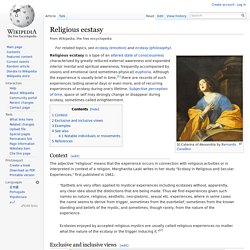
Marghanita Laski writes in her study "Ecstasy in Religious and Secular Experiences," first published in 1961: Audios/ Mix INSTRUMENTS de méditation (sources) "The Soothing Sun" (w Music) 1 Hour of Sunrises & Sunsets from around the World. III.A. Natural Healing. Pagan.
Cultivating the Spirit of Religion. What’s Wrong With Polygamy And Beastiality? - Rhyme and Reason by Philip Brocoum. Sociedade Taoista do Brasil » Não-Ação / Wu Wei. By Rafael • • 11 dez 2012 “O caminho é uma constante não-ação Que nada deixa por realizar.”
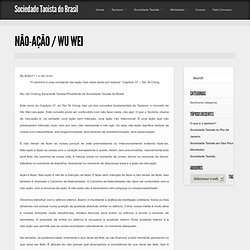
Capítulo 37 – Tao Te Ching Wu Jyh Cherng Sacerdote Taoísta Presidente da Sociedade Taoísta do Brasil Este verso do Capítulo 37, do Tao Te Ching, traz um dos conceitos fundamentais do Taoísmo: o conceito de Wu Wei não-ação. Este conceito pode ser confundido com não fazer nada, não agir. É não deixar de fazer as coisas porque se está premeditando ou intencionalmente evitando fazê-las. Ação é fazer. Devemos trabalhar com o silêncio interior. Na verdade, só podemos saber realmente o que deve ser feito se não ficarmos a todo momento pensando no que deve ser feito. Através da quietude, atinge-se a consciência. Qual é a diferença entre mente e consciência? A pessoa calma é aquela com menos diálogos interiores, com menos “eus” falando. Na meditação, a mente fica subordinada à consciência. O silêncio interior é o que Lao Zi chama de não-ação. Omnism. Omnism is the belief in all religions , as well as atheism; those who hold this belief are called omnists (or Omnists ).
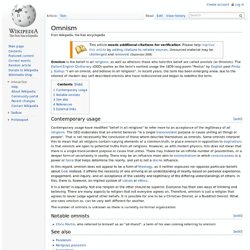
The Oxford English Dictionary (OED) quotes as the term's earliest usage the 1839 long poem "Festus" by English poet Philip J. Bailey : "I am an omnist, and believe in all religions". In recent years, the term has been emerging anew, due to the interest of modern day self-described omnists who have rediscovered and begun to redefine the term. [ edit ] Contemporary usage. Nondualism. Nondualism, also called non-duality, "points to the idea that the universe and all its multiplicity are ultimately expressions or appearances of one essential reality.
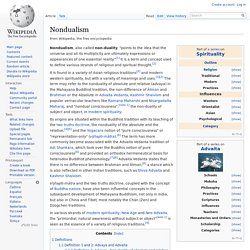
" It is a term and concept used to define various strands of religious and spiritual thought. Hoʻoponopono. Hoʻoponopono (ho-o-pono-pono) is an ancient Hawaiian practice of reconciliation and forgiveness.
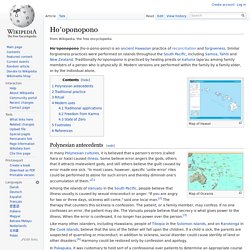
Similar forgiveness practices were performed on islands throughout the South Pacific, including Samoa, Tahiti and New Zealand. Traditionally hoʻoponopono is practiced by healing priests or kahuna lapaʻau among family members of a person who is physically ill. Modern versions are performed within the family by a family elder, or by the individual alone. Polynesian antecedents[edit] Higher consciousness. Higher consciousness is the consciousness of a higher Self, transcendental reality, or God.

Theosophy. Theosophy comes from the Greek theosophia (θεοσοφία), which combines theos (θεός), "God"[3] and sophia (σοφία), "wisdom," meaning "divine wisdom.
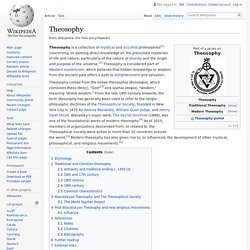
" From the late 19th century onwards, the term theosophy has generally been used to refer to the religio-philosophic doctrines of the Theosophical Society, founded in New York City in 1875 by Helena Blavatsky, William Quan Judge, and Henry Steel Olcott. Blavatsky's major work, The Secret Doctrine (1888), was one of the foundational works of modern theosophy.[4] As of 2015[update], members of organizations descended from, or related to, the Theosophical Society were active in more than 52 countries around the world. [a] Modern theosophy has also given rise to, or influenced, the development of other mystical, philosophical, and religious movements.[5] Etymology[edit]
Anima mundi. World soul Therefore, we may consequently state that: this world is indeed a living being endowed with a soul and intelligence ... a single visible living entity containing all other living entities, which by their nature are all related.[1] Other resemblances can be found in the thoughts of hermetic philosophers like Paracelsus, and by Baruch Spinoza, Gottfried Leibniz, Friedrich Schelling and in Hegel's Geist ("Spirit"/"Mind").

Ralph Waldo Emerson published "The Over-Soul" in 1841, which was influenced by the Hindu conception of a universal soul. There are also similarities with ideas developed since the 1960s by Gaia theorists such as James Lovelock. [citation needed] Spiritual practice. A spiritual practice or spiritual discipline (often including spiritual exercises ) is the regular or full-time performance of actions and activities undertaken for the purpose of cultivating spiritual development .

A common metaphor used in the spiritual traditions of the world's great religions is that of walking a path. [ 1 ] Therefore a spiritual practice moves a person along a path towards a goal. Mental plane. Predecessors of the concept[edit] In India in the seventh century b.c.e., the Taittiriya Upanishad referred to five levels of self, of which the middle one is the "self made of mind" (manas) Although the text is describing the nature of the individual rather than the cosmos as a whole, it established the concept of mind as only one of a series of ontological layers of being.
The Taittiriyan concept of the five selves would represent an important element of Vedantic ontology, for example the five koshas of Advaita Vedanta. Theosophical and Hermetic interpretations[edit] Spiritualism (beliefs) It is also a term commonly used for various psychic or paranormal practices and beliefs recorded throughout humanity's history[2][3] and in a variety of cultures.[4][5] Spiritualistic traditions appear deeply rooted in shamanism and perhaps are one of the oldest forms of religion.
Mediumship is a modern form of shamanism and such ideas are very much like those developed by Edward Burnett Tylor in his theory of animism,[6] in which there are other parallel worlds to our own, though invisible to us and not accessible to us in our state. A psychic is to be one of the connecting link between these worlds. A psychic is defined as someone endowed with exceptional sensitivity to the occult dimension, who experiences visions and revelations. Some authors have stated only few individuals are said to have this capacity.[7]
Abraxas. Abraxas (Gk. ΑΒΡΑΣΑΞ, which is far more common in the sources than the variant form Abraxas, ΑΒΡΑΞΑΣ)[citation needed] was a word of mystic meaning in the system of the Gnostic Basilides, being there applied to the “Great Archon” (Gk., megas archōn), the princeps of the 365 spheres (Gk., ouranoi).[1] The seven letters spelling its name may represent each of the seven classic planets—Sun, Moon, Mercury, Venus, Mars, Jupiter, and Saturn.[2] There are similarities and differences between such figures in reports about Basilides's teaching, ancient Gnostic texts, the larger Greco-Roman magical traditions, and modern magical and esoteric writings. Opinions abound on Abraxas, who in recent centuries has been claimed to be both an Egyptian god and a demon.[3] The Swiss Psychologist Carl Jung wrote a short Gnostic treatise in 1916 called The Seven Sermons to the Dead, which called Abraxas a god higher than the Christian God and devil that combines all opposites into one being.
Sources[edit] Miracle of the Sun. Location of Fátima, Portugal The Miracle of the Sun (Portuguese: O Milagre do Sol) was an event which occurred on 13 October 1917, attended by 30,000 to 100,000 people gathered near Fátima, Portugal. Several newspaper reporters were in attendance and they took testimony from many people who claimed to have witnessed extraordinary solar activity. This recorded testimony was later added to by an Italian Catholic priest and researcher in the 1940s. According to these reports, the event lasted approximately ten minutes. Great Architect of the Universe. Science, and particularly geometry and astronomy, was linked directly to the divine for most medieval scholars. Since God created the universe after geometric and harmonic principles, to seek these principles was therefore to seek and worship God.